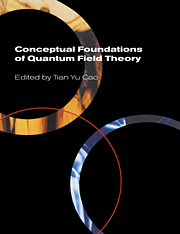Book contents
- Frontmatter
- Contents
- List of contributors
- Preface
- Photographs of the conference
- Introduction: Conceptual issues in quantum field theory
- Part One Philosophers' interest in quantum field theory
- Part Two Three approaches to the foundations of quantum field theory
- Part Three
- Part Four Mathematics, statistics and quantum field theory
- Part Five Quantum field theory and space-time
- Part Six
- Part Seven Renormalization group
- Part Eight Non-Abelian gauge theory
- 20 Gauge fields, gravity and Bohm's theory
- 21 Is the Aharonov–Bohm effect local?
- Part Nine The ontology of particles or fields
- Part Ten
- Name index
- Subject index
20 - Gauge fields, gravity and Bohm's theory
Published online by Cambridge University Press: 22 September 2009
- Frontmatter
- Contents
- List of contributors
- Preface
- Photographs of the conference
- Introduction: Conceptual issues in quantum field theory
- Part One Philosophers' interest in quantum field theory
- Part Two Three approaches to the foundations of quantum field theory
- Part Three
- Part Four Mathematics, statistics and quantum field theory
- Part Five Quantum field theory and space-time
- Part Six
- Part Seven Renormalization group
- Part Eight Non-Abelian gauge theory
- 20 Gauge fields, gravity and Bohm's theory
- 21 Is the Aharonov–Bohm effect local?
- Part Nine The ontology of particles or fields
- Part Ten
- Name index
- Subject index
Summary
Introduction
Recently, the following question appeared in the American Journal of Physics (Andereck, 1995): how can gravity be unified with the other fundamental forces when it is not a force at all, but an aspect of the geometry of space-time? In general relativity (GR) the gravitational field is the space-time metric, but in the standard model of quantum field theory the electro-weak and strong forces are manifestations of massless vector particles - of gauge fields. If our most complete contemporary theories treat forces so differently how can they be unified?
Roughly, there are two kinds of answers; either all four fundamental forces are aspects of the geometry of space-time, so the vector fields are also absorbed into the metric. Or, gravity is a force field like the other fundamental forces, so GR is formulated somehow as a gauge theory with curved space-time as an effective low energy approximation. Both proposals put all the forces on a similar footing.
But the primary interest of this paper is not unification, in any of its senses. Rather we want to consider the other questions raised here. What is gravity? What are forces more generally? How does gravity relate to the other forces? These questions are as old as physics, and have been reposed and reinterpreted after every revolution in physical thought. In the present century, remarkable progress has been made in finding potentially definitive anwers to them, and this paper is intended as an account of this work.
- Type
- Chapter
- Information
- Conceptual Foundations of Quantum Field Theory , pp. 287 - 297Publisher: Cambridge University PressPrint publication year: 1999
- 1
- Cited by



